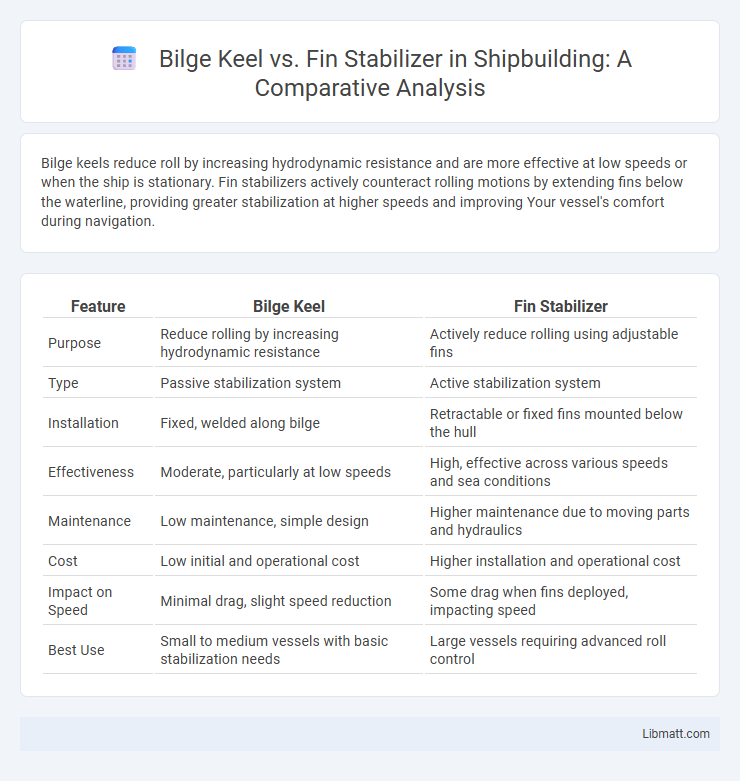Bilge keels reduce roll by increasing hydrodynamic resistance and are more effective at low speeds or when the ship is stationary. Fin stabilizers actively counteract rolling motions by extending fins below the waterline, providing greater stabilization at higher speeds and improving Your vessel's comfort during navigation.
Table of Comparison
| Feature | Bilge Keel | Fin Stabilizer |
|---|---|---|
| Purpose | Reduce rolling by increasing hydrodynamic resistance | Actively reduce rolling using adjustable fins |
| Type | Passive stabilization system | Active stabilization system |
| Installation | Fixed, welded along bilge | Retractable or fixed fins mounted below the hull |
| Effectiveness | Moderate, particularly at low speeds | High, effective across various speeds and sea conditions |
| Maintenance | Low maintenance, simple design | Higher maintenance due to moving parts and hydraulics |
| Cost | Low initial and operational cost | Higher installation and operational cost |
| Impact on Speed | Minimal drag, slight speed reduction | Some drag when fins deployed, impacting speed |
| Best Use | Small to medium vessels with basic stabilization needs | Large vessels requiring advanced roll control |
Introduction to Bilge Keels and Fin Stabilizers
Bilge keels are fixed, fin-like structures attached along the hull's bilge to reduce roll motion by increasing hydrodynamic resistance during a ship's side-to-side movement. Fin stabilizers, equipped with actively controlled fins extending from the hull, generate lift forces to counteract rolling, providing enhanced stability especially at higher speeds. Both systems play crucial roles in improving onboard comfort and safety by minimizing the vessel's rolling motions in various sea conditions.
Core Functions: How Bilge Keels Work
Bilge keels are fixed fins attached along the hull's bilge area designed to reduce rolling motion by increasing hydrodynamic resistance as the ship rocks side to side. Their core function involves dampening roll by creating drag in the water, which stabilizes the vessel without requiring active control systems or external power. Unlike fin stabilizers, bilge keels are passive and low-maintenance, making them effective for smaller vessels or ships operating at lower speeds.
Core Functions: How Fin Stabilizers Work
Fin stabilizers operate by extending fins from the hull below the waterline, adjusting their angle to counteract rolling motion caused by waves, thus enhancing vessel stability. Unlike bilge keels, which rely on passive resistance to dampen roll through fixed fins along the hull, fin stabilizers use active control systems to detect and respond to wave movement in real time. Your vessel's performance in rough seas can be significantly improved with fin stabilizers due to their dynamic response and precise roll reduction capabilities.
Key Differences Between Bilge Keels and Fin Stabilizers
Bilge keels are simple, fixed fins attached to the hull's bilge area, reducing roll by increasing hydrodynamic resistance, while fin stabilizers are active systems with adjustable fins that dynamically counteract rolling motion. Bilge keels require no power or control systems and are maintenance-free, making them cost-effective but less efficient in heavy seas, whereas fin stabilizers improve stability significantly but need power, sensors, and regular upkeep. Your choice depends on vessel size, cost constraints, and desired roll reduction effectiveness, with fin stabilizers favored for larger ships and bilge keels suited for smaller or less complex vessels.
Advantages of Bilge Keels
Bilge keels provide a cost-effective and low-maintenance solution for improving a vessel's stability by reducing rolling motion without requiring complex mechanical systems. Their fixed design ensures durability and minimal risk of damage or failure compared to fin stabilizers, which rely on moving parts and active control. You benefit from simpler installation and enhanced safety in shallow or debris-filled waters where fin stabilizers may be less effective.
Advantages of Fin Stabilizers
Fin stabilizers offer superior roll reduction compared to bilge keels, enhancing onboard comfort during rough seas. These active devices adjust dynamically to wave conditions, providing more effective stabilization and improving fuel efficiency by reducing hull resistance. Your vessel benefits from increased stability, especially at cruising speeds, making fin stabilizers ideal for yachts and larger ships requiring optimal performance.
Performance: Stability and Comfort Compared
Bilge keels provide effective passive stability by reducing roll motion through hydrodynamic drag, making them low-maintenance and reliable for moderate sea conditions. Fin stabilizers actively counteract roll with extendable fins controlled by gyroscopic sensors, delivering superior performance and increased comfort in rough waters. Your choice depends on vessel size and operational needs, with fin stabilizers excelling in comfort and bilge keels offering simpler, cost-effective stability.
Installation and Maintenance Costs
Bilge keels offer a cost-effective installation with minimal structural modifications and low maintenance expenses due to their simple design and lack of moving parts. Fin stabilizers involve higher initial installation costs as they require internal space for actuators and hydraulic systems, along with regular maintenance to ensure optimal performance and prevent mechanical wear. Your choice depends on balancing upfront investment against ongoing upkeep demands and vessel operational requirements.
Suitability for Different Vessel Types
Bilge keels are ideal for smaller vessels such as fishing boats and sailboats due to their simple design and low maintenance requirements, providing passive roll reduction without energy consumption. Fin stabilizers are better suited for larger commercial ships and yachts, offering active stabilization through adjustable fins that counteract rolling motions effectively, especially at higher speeds. The choice between these systems depends on vessel size, operational speed, and the need for dynamic roll control.
Conclusion: Choosing the Right Stabilization System
Bilge keels provide passive stabilization by reducing roll through hydrodynamic drag, making them low-maintenance and cost-effective for smaller vessels or calm water conditions. Fin stabilizers offer active control with adjustable fins that counteract roll dynamically, ideal for larger ships requiring enhanced comfort and performance in rough seas. Your choice depends on vessel size, operational environment, and maintenance capacity, with fin stabilizers suited for maximum stability and bilge keels preferred for simplicity and durability.
Bilge keel vs fin stabilizer Infographic

 libmatt.com
libmatt.com